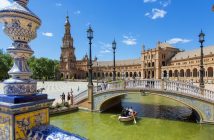The aerial views of Lisbon are worth booking a window seat for. Thick patches of green, strips of terracotta roof, golden sand and twinkling blues as the Atlantic Ocean meets the Tagus River. Just glimpsed through the clouds, the 25 de Abril suspension bridge and a replica of Christ the Redeemer makes it feel like you’re flying down to Rio and San Francisco simultaneously. At ground level, it’s not quite as breathtaking, initially. The twenty minute drive from Lisbon airport to the city centre is nothing special; lots of tired looking buildings, the odd Metro station – the usual outer city limits scenes. Then every now and again a glimmer of beauty in a building dressed head to toe in colourful ceramic tiles, offering a taste of what’s to be found further inside.
The façade of the Pousada de Lisboa is a vibrant vision of bright custard and icing sugar, a colour scheme reminiscent of the lip-smacking, sweet, egg-y treats found in the city’s bakeries and cafes. Its grandeur is emphasised by the connecting triumphal Rua Augusta Arch (built to commemorate the devastating earthquake of 1755) and the impeccably-maintained, 35,000 sq ft Praca do Comercio (Sqaure of Commerce), which stretches across to the river.
The Pousada de Lisboa, one of the Small Leading Hotels of the World and part of the Pestana de Portugal portfolio of Monument and Historic Hotels, opened in May 2015 and feels anything but new or small inside. 90 rooms, split into five categories, range from the relatively compact, but very comfortable, Classic, with modern design features such as glass cube bathrooms looking out to the rest of the room, to the 110 sq m, 18th century wood-panelled, Dom Perignon Suite. The public areas of this former Ministry of City Affairs are all long wide corridors and high ceilings with regal-toned carpets, marble floors, and plentiful plaster and cornice detailing. A partnership with the city museum makes it a hotel worth having a proper explore in, with various statues, paintings and artefacts on loan to add interest to every corner.

Old melds with new very well here, from the grand, duck egg blue and gold gilded Noble Salon, which looks like the setting of a period drama dance, to the modern, boxy spa with hammock chairs and swimming pool with retractable roof. A breakfast buffet of pastries, cold meats and the like is served in an impressive mosaic-floored courtyard, below a vertiginous glass ceiling, which also retracts in warmer months, and under the watchful eyes of the portraits that make up a replica of the St Vincent Panel. Everywhere you sit in this hotel, there’s something interesting to look at.
Lisbon has everything you want from a weekend city break, and the Pousada’s location is perfect for making the most of it when time is of the essence. The main shopping strip Rua Augusta is on its doorstep, and St Jorge Castle, with 360 views of the city and beyond, is within half an hour’s walk or a 10 minute tram from the main public transport hub, Praca de Figueria. Downtown is definitely a place to explore on foot, so you can appreciate the beautiful tiles, pastel-coloured buildings and handmade stone mosaic streets, stopping off for a coffee in one of the squares. But, to cover the whole of the city in less than a morning, there’s the Bike My Side sidecar tour company.
Over two hours, I saw and learnt more about Lisbon than would have otherwise been possible on a weekend break, through various viewpoints and places of interest and a generous dose of history and local knowledge from the rider. Yes, I resembled Muttley, and there wasn’t a person we passed who didn’t look amused, but it’s a darn site easier, quicker and more comfortable than walking up and down those hills. I spied a Saturday flea market I definitely want to spend a morning at next time, saw St Jorge Castle from almost every angle; was spoilt rotten with charming tiled buildings and picture-perfect narrow streets, and had a chance to stretch my legs and stock up on decorative tins of olive oil and sea salt at the Mercado da Ribeira, Lisbon’s main fresh produce market since 1892, partly revamped in 2014 by Time Out magazine to include food, drink, and gift stalls from local restaurants and shops.

It wouldn’t be a trip well spent without sampling plenty of the local dishes, and exclusively through Pestana’s offerings we did exactly that (bar a must-do detour to famous custard tart producers Pasteis de Belém, for a warm, cinnamon-sprinkled pastel de nata). Straight after check-in, we took a tram to St Jorge Castle, walked through the gardens, past orange and pine trees, and sauntering peacocks, to Casa do Leao. When the weather is fine, which is most of the year in Portugal, this former lion’s cage takes dining al fresco, with a row of tables looking straight down and over the city. The menu here centres on typical Portuguese cuisine, ‘with a twist of modern’: simple, hearty dishes of meat, fish and vegetables, such as the signature steak ‘Portuguese style’ (cooked with ham and bay leaf), served with sauté potatoes, glazed asparagus and carrots. Something these simple words don’t do justice, but after a 4am wake-up call, on this crisp November day, with a walk down the hill of hills on the cards, it was exactly what I needed.
The same young man who oversees the menu at Casa de Leao, twenty-something Executive Chef, Tiago Bonito, also creates the menu at Pousada de Lisboa’s restaurant, Lisboeta. It’s a place he’s clearly having a lot of fun experimenting at. In contrast to Casa de Leao’s subtle spin on tradition, here the menu is taken a step further adding theatre and excellence, in what was my favourite meal of the trip. I opted for two starters – having inhaled two of the aforementioned custard tarts less than an hour before – a beautiful delicate plate of giant red shrimp, lobster and Portuguese oyster, followed by a dainty, but deliciously rich marinated red partridge, with a crunch of breaded mushroom, sweet little quail egg, and wonderful Madeira sauce. Desserts were a mix of fun and invention, including a flaming stick to toast the marshmallow on one, and a revelatory goats’ cheesecake, shared around in traditional Portuguese ‘pijama’ style, where you take a spoonful and pass along.

For a special occasion, as much for the location as food, Valle Flor at the grand Pestana Palace (part of Pestana Collection Hotels portfolio), is also worth a look. This place oozes regal opulence, and is one to stop by for a cocktail and walk around at the very least. It’s where the A-listers stay when they’re in town, and where David Beckham posted a photo of the view from his Royal Suite window on Facebook only a few weeks’ before my visit. It’s where, under intricately painted trompe l’oeil arches and watchful cherubs, I ate the lightest, most delicious tempura shellfish, while learning it was in fact the Portuguese who passed the method on to the Japanese. John Dory baked in green wine was unveiled from a silver cloche for main, and dessert, because we were both slightly full and indecisive, was ordered in and dived into the ‘pijama’ way again. The Portuguese wines flowed easily, fuelling a new appreciation for the country’s bins, and the amuse bouche and breads were as delicious and plentiful as you’d expect from a top restaurant. If that wasn’t enough to finish me off, I returned to the Pousada to find a turn-down tray of mini custard tarts and bottle of Tawny Port waiting in my room.
After 24 hours of sufficient exploring and eating our way around Portugal’s capital, we drove along the coast road to the seaside town of Cascais, around 45 minutes away, to spend our final night in Portugal at the 4-star Pestana Cidadela. A member of the Leading Hotels of the World, this 16th century fortress is another gem from the Pestana Collections portfolio, and home to the Citadel Art District (CAD), the first of its kind in Europe. From the BFG-sized binoculars which greet you at the entrance, and a tree that looks very much like a real tree until you get right up close (the bright red trunk should’ve been a giveaway), to the 600 ceramic swallows that fly up the wall in the foyer, representing the 600 days it took to transform the Citadel of Cascais into a hotel, there’s much for the eyes to feast on; there’s even an in-house Art Concierge to talk you through on a complimentary tour. The rooms are compact due to building restrictions and care taken to maintain the original structure, but they’re not at all suffocating – a prime place to sleep, lounge and explore the area: which includes a typical seaside town centre on its doorstep, nearby surf spot and sand at Guincho, and World UNESCO Heritage Site, Sintra, an hour’s drive away.

For the best views, opt for a Superior Sea View, with double glass doors and a balcony looking on to the marina. A view that got me up at sunrise and carried me along the corridor to the spa and swimming pool, where it continued uninterrupted through floor to ceiling windows, adding entertainment to my morning swim and a place to lounge with tea post massage. 12 of the 126 rooms are labelled Art District, where bar the shell and the necessary bed and bathroom, decision on the design and contents are handed over to a different artist, right down to the music selection: a playful Playmobil-themed one by Brazilian, Heberth Sobral, was a personal highlight. Across the courtyard, below the hotel’s second-hand bookshop, Déjà Vu, is the tapas bar, Tabarna da Praca, which provided the last evening’s feast and the encouragement to doodle with the provided pencil and paper placemat.
All manner of dishes (priced from 3-15€) were ordered and laid out for us to share: the popular bacalhau (salted cod fish), clams braised in olive oil and garlic; slow-cooked duck rice; breaded balls of Portuguese sausage; a bowl of addictive potato skin chips and aioli I had to have moved to the other end of the table… Followed by an array of desserts served, you guessed it, ‘pijama’ style, including the star of the show 100% cacao chocolate mousse, and an obligatory tawny port to finish. As we ate and talked over the high points of the weekend, I asked the Portuguese member of the group to translate a line at the bottom of the menu. “It’s saying to ‘eat all up, and cry for more’, she said with a grin. As I walked back to my room, hand resting on my temporary pot belly, running the last 48 hours through my head, I couldn’t think of a better line to sum up my weekend dalliance in Portugal with Pestana.
TAP Portugal flies directly from London Heathrow, Gatwick and Manchester to Lisbon 60 times a week, return fares starting at £121 including all taxes and surcharges. For further information, visit www.flytap.com or call 0345 601 0932. Rates at Pousada de Lisboa start from 169 Euros per room per night and rates at Pestana Cidadela Cascais start from 112 Euros per room per night. for more information visit: www.pestana.com.




